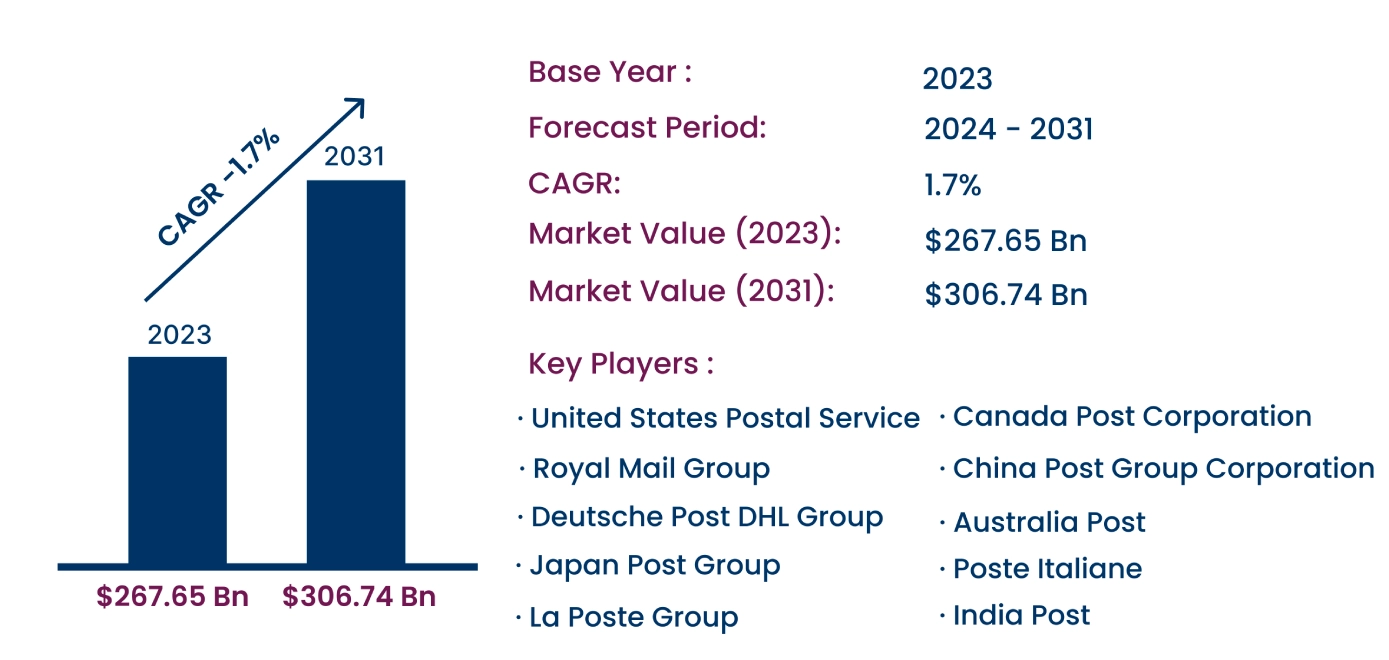Global Postal Services Market to Reach USD 306.74 Billion by 2031 | CAGR of 1.7%
Category : Industry Services | Published Date : Nov 2024 | Type : Press Release
Postal Services Market Scope & Overview:
In the newly published report, Consegic Business Intelligence states that The Postal Services Market was valued at USD 267.65 Billion in 2023 and is projected to reach USD 306.74 Billion by 2031, growing at a CAGR of 1.7% from 2023 to 2031. Postal services encompass the collection, processing, and delivery of mail, parcels, and other related services, playing a vital role in ensuring efficient communication and logistics support across various sectors. These services provide timely delivery and extensive coverage, catering to individuals, businesses, and government entities.
The report comprises the Postal Services Market Share, Size & Industry Analysis, By Service Type (Mail, Parcels, Express Services, Logistics), By Application (Retail and Commercial, Government, Others), By Delivery Type (Domestic, International), By Mode of Transportation (Air, Land, Water), By End-User (Individuals, Small and Medium-Sized Enterprises (SMEs), Large Enterprises), and By Region (North America, Europe, Asia-Pacific, Latin America, Middle East & Africa), and Forecast, 2024–2031.
The report contains detailed information on Postal Services Market Trends, Opportunities, Value, Growth Rate, Segmentation, Geographical Coverage, Company Profile, In-depth Expert Analysis, Revenue Forecast, Competitive Landscape, Growth Factors, Restraint or Challenges, Environment & Regulatory Landscape, PESTLE Analysis, PORTER Analysis, Key Technology Landscape, Value Chain Analysis, and Cost Analysis.
Rising demand for last-mile delivery services driven by e-commerce growth is a key factor propelling market expansion, while competition from private courier and logistics providers poses a significant challenge to traditional postal services.
Segmental Analysis :
By Service Type, the market is segmented into mail, parcels, express services, and logistics.
- Mail services held the largest revenue share in 2023, driven by steady demand from businesses and government agencies for official communications.
- Express Services are expected to register the fastest CAGR, supported by growing e-commerce activities and demand for time-sensitive deliveries.
By Application, the market includes retail and commercial, government, and others.
- The Retail and Commercial segment dominated the market share in 2023 due to the rising volume of package deliveries driven by online retail growth.
- The Government segment is projected to grow at the fastest rate, supported by increased use of postal services for official correspondence and public outreach.
By Delivery Type, the market is divided into domestic and international services.
- Domestic services accounted for the largest share in 2023, driven by local package deliveries and high demand for timely, reliable service.
- International services are expected to grow at the highest CAGR, fueled by expanding global trade and cross-border e-commerce.
By Mode of Transportation, the market is categorized into air, land, and water.
- Land Transportation accounted for the largest share of 65.80% in 2023, benefiting from cost-efficiency and extensive use for regional deliveries.
- Air Transportation is anticipated to witness the fastest growth, driven by the need for rapid and long-distance delivery solutions, particularly in international trade.
By End-User, the market is segmented into individuals, SMEs, and large enterprises.
- Large Enterprises held the largest revenue share in 2023, supported by the need for bulk shipping and customized postal solutions.
- SMEs are projected to register the fastest growth rate, benefiting from cost-effective postal services for order fulfillment and delivery.
Based on regions, the global market is segmented into North America, Europe, Asia-Pacific, Middle East & Africa, and Latin America.
- Asia-Pacific is expected to show significant growth, driven by rising e-commerce activities, particularly in China and India, and investments in logistics infrastructure.
- North America held a substantial share in 2023, supported by advanced digital technologies and a well-established postal network.
| Report Attributes | Report Details |
| Study Timeline | 2018-2031 |
| Market Size in 2031 | USD 306.74 Billion |
| CAGR (2024-2031) | 1.7% |
| By Service Type | Mail, Parcels, Express Services, Logistics |
| By Application | Retail and Commercial, Government, Others |
| By Delivery Type | Domestic, International |
| By Mode of Transportation | Air, Land, Water |
| By End-User | Individuals, Small and Medium-Sized Enterprises (SMEs), Large Enterprises |
| By Region | North America(U.S., Canada, Mexico) Europe(U.K., Germany, France, Spain, Italy, Russia, Benelux, Rest of Europe) APAC(China, South Korea, Japan, India, Australia, ASEAN, Rest of Asia-Pacific) Middle East & Africa(GCC, Turkey, South Africa, Rest of MEA) LATAM(Brazil, Argentina, Chile, Rest of LATAM) |
Top Key Players & Competitive Landscape :
The postal services market is highly competitive, with companies focusing on expanding their service offerings and enhancing efficiency through technological advancements.
List of prominent players in the Postal Services Industry:
- United States Postal Service (USPS) (United States)
- Royal Mail Group (United Kingdom)
- Japan Post Group (Japan)
- China Post Group Corporation (China)
- La Poste Group (France)
- Deutsche Post DHL Group (Germany)
- Canada Post Corporation (Canada)
- India Post (India)
- Australia Post (Australia)
- Poste Italiane (Italy)
Recent Industry Developments :
- In September 2024, the United States Postal Service (USPS) launched a holiday shipping plan to increase capacity and operational hours during the peak season.
- In April 2024, Royal Mail partnered with Alibaba's Tmall Network to enhance e-commerce logistics between the U.K. and China.
- In March 2024, Canada Post announced investments in a new fleet of electric vehicles as part of its sustainability initiatives aimed at achieving net-zero emissions by 2050.












